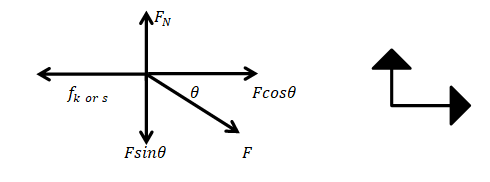
Concept explainers
In Fig. 6-12, if the box is stationary and the angle θ between the horizontal and force

Figure 6-12 Question 1.
To find:
Whether the following quantities increase, decrease, or remain the same when an applied force is directed downward at an angle
(a)
(b)
(c)
(d)
(e) And, whether the magnitude of the frictional force on the box increases, decreases, or remains the same if the angle θ is increased.
Answer to Problem 1Q
Solutions:
(a) The value of horizontal force
(b)
(c) The value of the normal force
(d)
(e) The friction force increases when the box slides and the angle between the surface and box also increases.
Explanation of Solution
Concepts
If the block slides, then kinetic frictional force is given by
Explanations:
Given Data:
In the problem (a) to (b): the box is stationary and the angle
Note: It is clear from Fig. 6-12, the angle
Formula used:
The free-body depiction for the inclined slope is provided below.
From Fig. (6-19) of the textbook and the free body diagram, we can draw:

No acceleration in the first case (from (a) to (d)) as the box is in the stationary position. Hence, acceleration is zero.
Applying Newton’s 2nd law on the y-axis:
If the block slides, the kinetic frictional force:
If it does not slide, then the magnitude of maximum static friction:
Calculations: To find the magnitude of the different forces and their nature (increasing, decreasing, or no-change) when the angle (
(a) The horizontal component of the force is
(b) If a body does not move, the static frictional force and the component parallel to the surface are equal in magnitude, and is directed opposite that component. If the component decreases,
(c) The normal component of the force is given in Eq. (1).
The normal component of the force is
(d) From Eq. (3), the magnitude of the maximum static friction will also increase as
(e) In the sliding scenario, kinetic friction force can be explained by Eq. (2). This results in an increase in the kinetic frictional force. Thus, the friction force increases when the box slides and the angle between the surface and box increases.
Conclusion
If the value of the normal force
Want to see more full solutions like this?
Chapter 6 Solutions
Fundamentals Of Physics - Volume 1 Only
Additional Science Textbook Solutions
Chemistry: A Molecular Approach (4th Edition)
Chemistry: Structure and Properties (2nd Edition)
Cosmic Perspective Fundamentals
Campbell Biology (11th Edition)
Physics for Scientists and Engineers: A Strategic Approach, Vol. 1 (Chs 1-21) (4th Edition)
Human Biology: Concepts and Current Issues (8th Edition)
- air is pushed steadily though a forced air pipe at a steady speed of 4.0 m/s. the pipe measures 56 cm by 22 cm. how fast will air move though a narrower portion of the pipe that is also rectangular and measures 32 cm by 22 cmarrow_forwardNo chatgpt pls will upvotearrow_forward13.87 ... Interplanetary Navigation. The most efficient way to send a spacecraft from the earth to another planet is by using a Hohmann transfer orbit (Fig. P13.87). If the orbits of the departure and destination planets are circular, the Hohmann transfer orbit is an elliptical orbit whose perihelion and aphelion are tangent to the orbits of the two planets. The rockets are fired briefly at the depar- ture planet to put the spacecraft into the transfer orbit; the spacecraft then coasts until it reaches the destination planet. The rockets are then fired again to put the spacecraft into the same orbit about the sun as the destination planet. (a) For a flight from earth to Mars, in what direction must the rockets be fired at the earth and at Mars: in the direction of motion, or opposite the direction of motion? What about for a flight from Mars to the earth? (b) How long does a one- way trip from the the earth to Mars take, between the firings of the rockets? (c) To reach Mars from the…arrow_forward
- No chatgpt pls will upvotearrow_forwarda cubic foot of argon at 20 degrees celsius is isentropically compressed from 1 atm to 425 KPa. What is the new temperature and density?arrow_forwardCalculate the variance of the calculated accelerations. The free fall height was 1753 mm. The measured release and catch times were: 222.22 800.00 61.11 641.67 0.00 588.89 11.11 588.89 8.33 588.89 11.11 588.89 5.56 586.11 2.78 583.33 Give in the answer window the calculated repeated experiment variance in m/s2.arrow_forward
 Classical Dynamics of Particles and SystemsPhysicsISBN:9780534408961Author:Stephen T. Thornton, Jerry B. MarionPublisher:Cengage Learning
Classical Dynamics of Particles and SystemsPhysicsISBN:9780534408961Author:Stephen T. Thornton, Jerry B. MarionPublisher:Cengage Learning Principles of Physics: A Calculus-Based TextPhysicsISBN:9781133104261Author:Raymond A. Serway, John W. JewettPublisher:Cengage Learning
Principles of Physics: A Calculus-Based TextPhysicsISBN:9781133104261Author:Raymond A. Serway, John W. JewettPublisher:Cengage Learning

